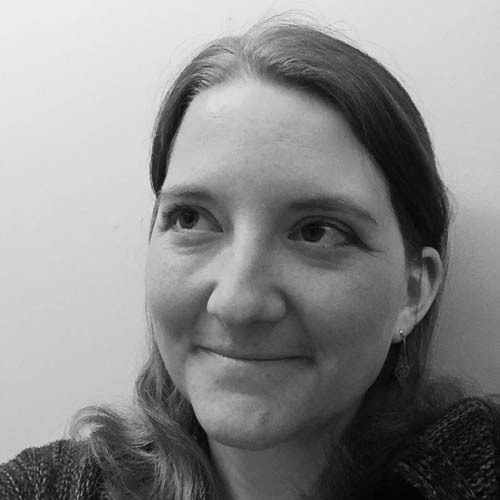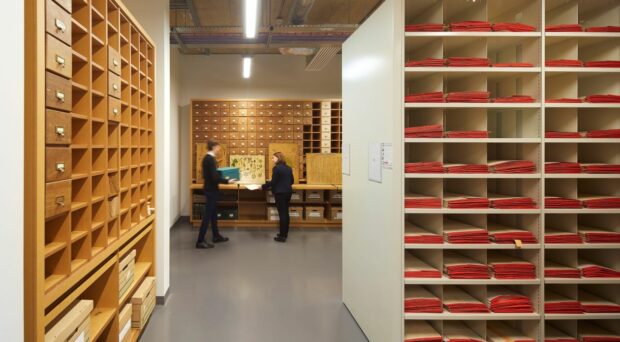The Reeshe (meaning ‘roots’ in Farsi) Persian School supports children to learn all about Persian language, culture, and heritage. Recently they visited the Fitzwilliam Museum to explore some very special Persian objects.
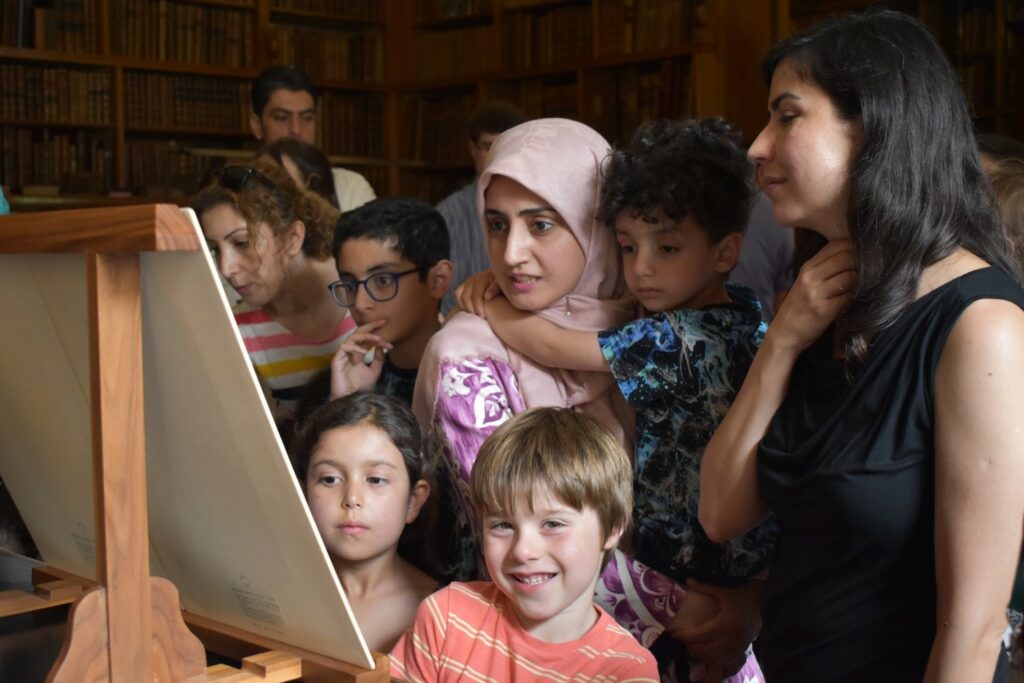
Like many Museum activities, the visit was the result of teamwork. Here those involved share their input:
Suzanne Reynolds and Monika Stokowiec work in the Department of Manuscripts & Printed Books. They welcomed families into the Founder’s Library to share some incredible Persian manuscripts with them.
Suzanne & Monika – can you tell us about the objects you chose to show the group?
‘We showed two manuscripts and a selection of miniatures.
One of the books was a large Persian Qur’an, MS 81-1972. This manuscript was written between 28th January and 5th February in 773 AH (that is 1372 CE) – this exact date is written in the scribe’s note at the end of the manuscript. The stunning illumination at the beginning is a later addition and dates to the 16th century. The manuscript is written on burnished paper and bound into a traditional Persian binding with an envelope flap. The binding is highly decorative. The outside is block stamped in gold while intricate filigree cut out from very thin leather painted with gold and laid over colourful paper decorates the inside of the boards.
The other manuscript, MS 262-1949, is a smaller volume containing selection of poetry from Bustan of Sa’di, and it dates to mid-16th century CE (approximately 950-970 AH). This manuscript was made using papers dyed in different colours using natural dyes based on traditional Persian recipes which still survive from the Medieval times. The recipes themselves were written as poems to help memorise them. The borders of the leaves are decorated with elaborate floral designs painted with gold.
The miniatures we chose were from the manuscript containing Sa’di’s poetry and from Ferdowsi’s Shahnameh, the Book of Kings, MS 22-1948, dating to the 15th century CE. The miniatures shown depicted different scenes among which was Kay Kaus in his flying machine!’
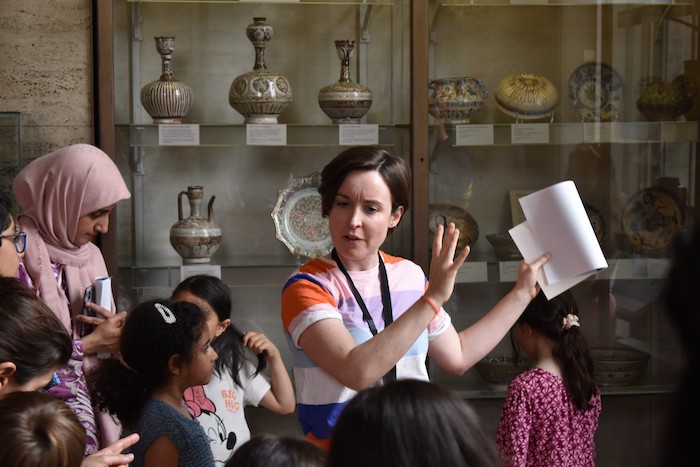
Families also met Flavia Ravaioli, a Conservator at the Museum who is currently researching Islamic ceramics.
Flavia: what are you finding out through your research, and how did you share this with the families?
‘We are investigating the materials and methods used in making medieval Iranian ceramics. In particular, we have carried out scientific analysis on an important collection from Gurgan, Iran, identifying pigments used in glazes and metals used in lustreware. I talked to the children about how we had found out about the ancient techniques used to create these beautiful objects, explaining that science and art come together in this type of study. As part of our research project we are collaborating with an Iranian artist and scholar, Dr Abbas Akbari, who creates reproductions of medieval lustreware using historic techniques. The children were able to handle some of the reproductions and experience the last stage of the making process, by polishing off the clay medium used to apply the metal finish, revealing the shiny lustre surface underneath.’
Having explored some beautiful artworks from the Museum’s collection, the group took some time in the Studio to make their own miniature paintings inspired by what they had seen. Adults and children painted on upcycled mounting board left over from exhibitions using powder paint made from naturally occurring minerals and pigments, lovingly prepared by Studio Assistant Molly Blacknell.
Molly: can you explain the thinking behind using natural and sustainable materials in these kind of art workshops?
‘Before the invention of acrylic paint and PVA glue, artists and craftspeople had to work with the natural world to create materials that were beautiful, effective, and sustainable. This aspect of the creative process is something that interests us greatly down in the Fitzwilliam Museum’s Education Studio, and we want to work to promote a harmonious relationship between nature and craft – learning from the expertise of the past and bringing it into modern practices today. Our decision to work with natural paint pigments reflects the beautiful Persian manuscripts we were looking at in the Founders Library – each of those being made of pigments sourced from plants, animals, and the earth. We hope this gave the participants a sense of connection to the collection – working in the same mediums used for hundreds of years. There is a beautiful feeling of timelessness to mixing your own paint with pigment – it feels universal, elemental, and exciting.
Using these paints on beautiful, high quality mounting board (recycled from past Exhibitions at the Fitz) was a real pleasure and no doubt informed the high quality of making. We believe that everyone should have access to quality art materials, and are constantly striving towards this whilst placing a focus on sustainability – reusing what we have here at the museum first and foremost.’
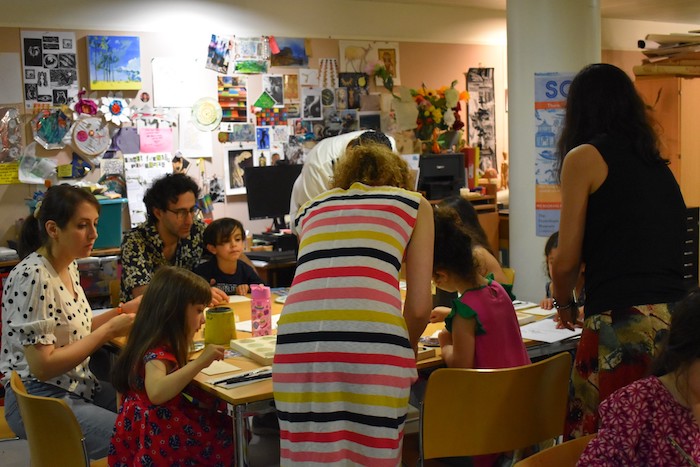
Maryam Ozlati is the founder of Reeshe Persian School and a parent.
Maryam: how did you find the experience and what do you think museums can support the work of bilingual and supplementary schools?
‘Our school had an incredible experience during the tour. The children were truly captivated by the exquisite Persian manuscripts and other fascinating Persian artifacts. Museums play a vital role in nurturing the multicultural identity of bilingual children, allowing them to develop a stronger connection to their home culture. For some children who may not have the chance to visit their parents’ country, museums provide a unique opportunity to explore and understand their roots and origins on a deeper level.’
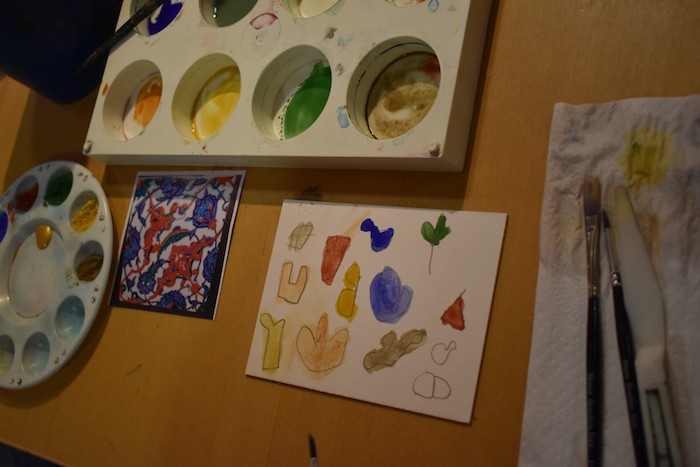
Many of the young artists wanted to take their paintings home, but we have a small selection on display in the basement next to the Studio – come and have a look the next time you are at the Museum. We all enjoyed working together on this event, and hope to collaborate with Reese Persian School and others in the Cambridge Research in Community Language Education network in the future.
If you are interested in finding out more about the Museum’s educational activities for children, families, and schools please have a look at our website. To contact the Reeshe Persian School, please email persiancambridgeschool@gmail.com.

